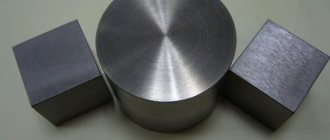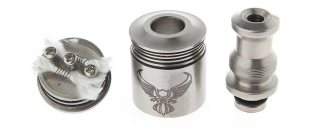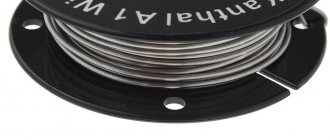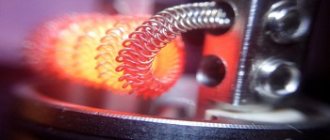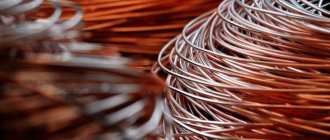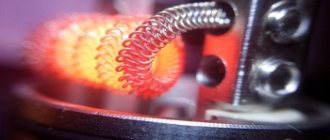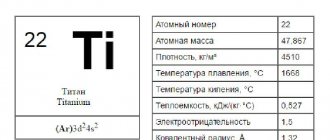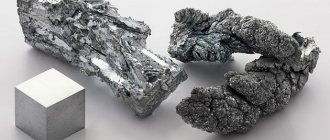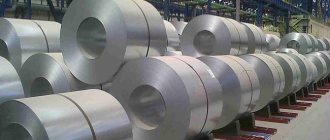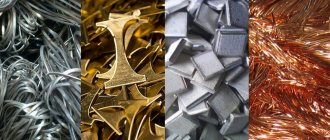Nichrome is an alloy of 80% nickel and 20% chromium with a melting point close to 1400 C. It is gray in color and is resistant to corrosion. Due to its high resistance and difficult oxidation at high temperatures, it is widely used in manufacturing. Nichrome wire is a resistive material that is used to improve the high temperature performance of many materials at very high temperatures where other conductive metal elements cannot operate.
Compound
Nichrome contains about 20% nickel and up to 80% chromium.
In addition, the alloy may contain additives in the form of manganese, aluminum, iron, silicon, etc.
The introduction of alloys into the nichrome composition increases the performance indicators and technical parameters of the metal:
- nickel and iron improve machinability;
- iron, titanium, aluminum and manganese reduce resistance to elevated temperatures;
- In the presence of iron in the alloy, nichrome acquires magnetic properties.
Increasing additives can degrade the characteristics of the metal.
The amount of nickel determines the temperature that the heating elements can withstand.
The chromium content in the alloy should be no more than 20%. An increase in the amount of chromium increases the brittleness and impairs the machinability of the metal. When its content in the alloy is more than 30%, cold rolling and drawing of the material becomes impossible.
The strength of the protective film and oxidation resistance depend on the amount of chromium.
Invention
• Specialists from the American company Driver-Harris Company first developed and created an alloy based on Nickel-Chromium in 1905. The development was led by scientist and metallurgist Albert Leroy Marsh. After this, the nichrome era of heaters began, which led to the creation of an international classification of this alloy.
Properties of nichrome
The alloy is characterized by good ductility and high electrical resistance. Its value can range from 1100 to 1400 Ohm mm²/m, depending on the type of metal.
Table 1. Technical characteristics of nichrome.
| Options | Indicators |
| Strength | 650-700 MPa |
| Melting temperature | 1100-1400°С |
| Working temperature | 800-1100°С |
| Density | Up to 8200-8500 kg/m3 |
| Resistance | 650-700 MPa |
| Coefficient of thermal conductivity | 11.3 W/(m K) |
| Linear thermal resistance coefficient | 14·10¯⁶Kˉ¹ |
| Ultimate tensile strength | 0.65-0.70 GPa |
Products made from nichrome are easily deformed while maintaining the given shape.
Nichrome does not have magnetic properties, with the exception of an alloy that contains an iron alloy.
Figure 2. Heating element.
Content
Nichrome: description and characteristics
Fechral: description and characteristics
Nichrome and Fechral: what is the difference between the alloys
Nichrome and Fechral
- This is a group of precision alloys that are characterized by high electrical resistance. This explains their main application - the production of heating elements for electrometric equipment. However, despite being related to the same group of alloys and having similar practical applications, these materials have differences in chemical composition and in physical and mechanical properties.
Nichrome brands
The most common brands in the industry include:
- X20N80 is a classic alloy containing about 20% chromium and 80% nickel;
- X15N60 - the alloy has reduced chromium and nickel content, increased iron content to 25%;
- Kh20N80-N (-N-VI) and Kh15N60 (-N-VI) - alloys produced in vacuum induction furnaces;
- N50K10, X25N20 - grades of nichrome used for work at temperatures up to 900°C.
Alloys produced in vacuum induction furnaces are distinguished by the fact that their electrical resistance changes little with temperature changes.
Explanation of brands:
- X – chromium (Cr);
- N – nickel (Ni);
The numbers indicate the percentage of the composition.
Additional letters mean:
- VI - vacuum induction melting;
- H - category of heating elements;
- C - use in resistance elements;
- Heating element - intended for dry type electric heaters.
For example, the brand X20N73YUM-VI indicates: chromium content - 20%, nickel - 73%, aluminum - 3%, molybdenum - 1.5%, manganese - up to 0.3%, titanium - up to 0.05%, iron - 2 %, carbon - up to 0.05%. The alloy was smelted using the vacuum induction method.
The purpose and properties of nichrome products are determined by the chemical composition of the alloy.
International designations
In the international names of nichrome you can find the following designations:
- Cronix 80;
- NiCr80/20;
- Nichrome V;
- Chromel A;
- HAI-NiCr 80;
- Ni80Cr20;
- Nikrothal 8;
- Resistohm 80;
- euronichrome.
European analogues of ferronichrome: NiCr60/15, Ni60Cr15, ChromelCN6, Nikrothal 6, Nikrothal 60, CroniferII, AlloyC.
Advantages and disadvantages
Nichrome alloys are characterized by high electrical resistance.
The resistivity of nichrome is 10 times higher than that of galvanized steel and 70 times higher than that of copper.
Other advantages include:
- high mechanical strength and hardness;
- heat resistance and absence of temperature deformation;
- low specific gravity and good ductility;
- resistance to corrosion and aggressive environments;
The material is easy to process: sharpening, stamping, welding, etc. It does not change its characteristics when exposed to high temperatures.
Due to its resistance to corrosion and aggressive external environments, the alloy has an almost unlimited service life.
The disadvantages of the material include high cost.
Reducing the percentage of chromium in the alloy makes the product cheaper, but also reduces the technical properties of the material.
Fechral: description and characteristics
Fechral
– an alloy in the chemical composition of which the main components are iron (Fe), chromium (Cr) and aluminum (Al), hence the name. Most often, the percentage of elements in the alloy composition is as follows: Fe - 5.0-5.5%, Cr - 12.0-15.0%, Al - 3.5-5.5%, manganese may also be present in the composition, silicon and titanium.
The most popular Fehrali grades are FeCrAl 125, FeCrAl 135, FeCrAl 140, FeCrAl 145 and FeCrAl H.
Very often Fechral is called Kantal. In principle, these are the same alloy - FeCrNi, but Kanthal is the registered name of the manufacturer of wire made from the fechral alloy.
The most popular are the three types of Kanthal:
- Kanthal D
is an alloy with a chemical composition of 4.8% aluminum; - Kanthal A
is an alloy with a chemical composition of 5.3% aluminum; - Kanthal A-1
is an alloy whose chemical composition is 5.8% aluminum.
Differences in the percentage of aluminum in the chemical composition of the alloys have little effect on the resistivity.
You can also find such names for fechral as: eurofechral, megapir, Aluchrom, Resistohm.
Main properties of fechral:
- maximum operating temperature - 14000C; melting point of fechral – 15000C;
- high electrical resistivity;
- resistance to increased surface loads;
- resistance to oxidation in sulfur-based atmospheres;
- high heat resistance and resistance to oxidation in air;
- excellent plasticity and ability to hold its shape for a long time;
- durability.
Wire, rods, tapes, plates, and heating coils are made from fechral grades.
This rolled metal is used in:
- production of heating elements in powerful industrial and laboratory furnaces;
- production of resistors for electric locomotives and multiple unit rolling stock;
- production of household appliances: dryers, ovens, etc.;
- production of resistors and resistance blocks;
- production of electronic cigarettes.
Making wire and tape from nichrome
Almost all electric stoves and electrical appliances use nichrome wire, thread or tape as heating elements.
There are several ways to make products from nichrome:
- Wire and thread drawing with intermediate heat treatment. Immediately before drawing, wire rod with a diameter of 6-8 mm is heated in special furnaces to a temperature of 1170-1230°C and quickly cooled. The heating temperature of the workpiece depends on the composition of the alloy. The next stage is pickling the wire rod in a mixture of hydrochloric and nitric acid with water.
Nichrome wire drawing is performed using high pressure. The production of products by drawing method is regulated by the requirements of GOST 8803-89
- Drawing of a hot-rolled billet to obtain a nichrome strip. This method allows the output to be a high-quality strip that exactly matches the profile and cross-section of the drawing channel. The resulting tape is of high quality and has no sharp edges.
- Cold drawn broach. The method is used for the production of wire and threads from nichrome. It is carried out without preheating the workpiece. Regulated by GOST 12766.1-90
- Cold rolling. Used for making nichrome tape. Performed in accordance with the requirements of GOST 12766.2-90.
- Flattening - used to produce strips from precision alloys with high electrical resistance. Performed in accordance with GOST 12766.5-90.
Nichrome tape.
The dimensions, mechanical properties and other parameters of nichrome wire are regulated by state standards or technical specifications.
Areas of use
High corrosion resistance, the ability to work in aggressive conditions, and high-quality technical characteristics allow the material to be used in various fields.
In industrial installations and electrical equipment:
- high temperature electric furnaces;
- ventilation dryers;
- boilers and heat exchangers;
- welders;
- single-core and multi-core electrical wires;
- structural elements of metal-smelting equipment;
- powder paint polymerization chambers;
- devices for cutting foam;
- resistors, rheostats.
Heating elements made of nichrome are installed in car cigarette lighters, glass and seat heating systems in cars.
Special grades of complex alloyed nichrome with a low coefficient of electrical resistance are used as a heat-resistant coating when performing thermal spraying.
At home
The material is used in almost all modern household appliances:
- electric stoves and ovens;
- heaters and boilers;
- washing machines and toasters;
- hair dryers and irons;
- electric soldering irons and wood burning devices;
- electronic atomizers and light bulbs.
The use of spirals in household electric stoves.
Nichrome threads are widely used in medicine as a suture material during intracavitary surgical and plastic operations.
For each application, certain grades of alloys with optimal technical characteristics are produced.
Areas of application of the material
The alloy is actively used in heaters of industrial, household and laboratory classes. Nichrome spiral is used as the main heat element in high-heat resistance electric furnaces and dryers. Due to the properties of the material, it can be used in all devices where controlled heating is required.
For example, the X20N80 alloy is used in high-temperature electric resistance furnaces on an industrial scale. The brand is recommended for use for those devices where reliability requirements are higher than usual.
The areas of use of X15N60 are similar. In addition, the alloy of this brand is actively used in the creation of electronics, as well as electronic components. Based on X15N60, resistors of different power classes are created.
What is Resistance Heating Alloy
Resistive materials are materials that heat up to high temperatures when current passes through them.
The reliability, quality and technical characteristics of heating elements depend on the composition of the material.
The main types of resistive alloys include:
- Nichromes are alloys of nickel and chromium.
- Ferkhali - alloys of iron, chromium and aluminum.
- Multicomponent alloys, in which, in addition to chromium, aluminum, iron, alloying elements are added - copper, manganese, silicon, titanium.
The melting point of multicomponent alloys is 1500°C, and the service life of heating elements is 2-3 times longer than nichrome products.
Resistivity of nichrome and other alloys for heaters
Electrical resistivity determines the ability of a metal to prevent the passage of current. It is calculated as the ratio of the electric field to the current density and is measured in Ohm mm²/m.
Table 2. Resistivity of main alloys suitable for heating elements.
| Alloy | Resistivity | |
| ||
| 80 – Nickel, 20 – Chrome | 1.0803 Ohm mm2/m | |
| 80 – Nickel, 20 – Chrome | 1.18002 Ohm mm2/m | |
| 35 – Nickel, 20 – Chrome, 45 – Iron | 1.01382 Ohm mm2/m | |
| ||
| 73 – Iron, 22 – Chrome, 5 – Aluminum | 1.45425 Ohm mm2/m | |
| 74 – Iron, 22 – Chrome, 4 – Aluminum | 1.35453 Ohm mm2/m | |
| 81 – Iron, 15 – Chrome, 4 – Aluminum | 1.35453 Ohm mm2/m | |
| ||
| 55 – Copper, 45 – Nickel | 0.4986 Ohm mm2/m | |
| 89 – Copper, 11 – Nickel | 0.1495 Ohm mm2/m | |
| 98 – Copper, 2 – Nickel | 0.0498 Ohm mm2/m | |
The main factors in choosing an alloy for the manufacture of heaters are the combination of high electrical resistance and the ability to withstand extremely high temperatures for a long time.
Nichrome and Fechral: what is the difference between the alloys
The main difference between the alloys is the chemical composition, namely the nickel content in Nichrome and its absence in Fekhral.
This explains the difference in the mechanical and physical properties of the alloys:
- The resistivity of fechral is slightly higher than that of nichrome;
- nichrome is more resistant to cyclic temperature loads;
- nichrome heats up and cools faster than fechral;
- the plasticity of fechral is approximately 2 times lower than that of nichrome;
- nichrome has a higher emissivity during oxidation;
- nichrome is non-magnetic and suitable for use at low temperatures, and fechral loses its magnetic properties only at temperatures above 600°C;
- fechral is a more refractory and hard alloy, and therefore more brittle when twisted;
- the cost of nichrome is higher than the cost of fechral.
Both alloys have excellent properties; the choice depends on the scope of the product and the task at hand.
You can buy Nichrome or Fecral from the EMK company. We supply high-quality materials from leading European manufacturers, which is confirmed by relevant documentation.
Calculation of an electric spiral made of nichrome
The parameters of the spiral can be calculated using electronic calculators on the manufacturers’ website. By specifying the heater power, supply voltage and wire diameter, you can calculate the length of wire required for the heater coil.
Resistance calculation
It is calculated based on the diameter of the wire used or the cross-sectional area of the tape.
The total length of the wire is multiplied by the resistivity of one meter of conductor with the appropriate cross-section.
If the brand of alloy is known, the resistivity of the wire is taken from tables located in technical reference books, GOST or on the Internet.
If the alloy grade is unknown, the performance of the wire or finished spiral can be measured with a multimeter.
Using an online calculator, you can make a preliminary calculation of the spiral, but to accurately calculate the parameters of the heater, many more factors should be taken into account.
Nichrome spirals.
Length calculation
The length of the nichrome spiral depends on the resistivity and diameter of the wire and is determined by the formula: L=(Rπd2)/4ρ.
- R – wire resistance;
- d – wire diameter;
- ρ – resistivity of nichrome;
- π – constant = 3.14.
We take ρ nichrome from the table GOST 12766.1-90: ρ=1.0÷1.2 Ohm mm2/m.
Table 3. The relationship between current strength, diameter and cross-section of nichrome.
| Permissible current (I), A | 1 | 2 | 3 | 4 | 5 | 6 | 7 |
| Diameter (d) of wire at 700°C, mm | 0,17 | 0,3 | 0,45 | 0,55 | 0,65 | 0,75 | 0,85 |
| Wire cross-section (S), mm | 0,0227 | 0,0707 | 0,159 | 0,238 | 0,332 | 0,442 | 0,57 |
Example:
It is necessary to calculate the length of the wire for the spiral of the electric stove.
Tile power P = 800 W.
Mains voltage U=380 V.
Solution:
- We determine the current strength: I = P/U = 800/220 = 3.64 A.
- We determine the wire resistance R = U/I = 220/3.64 = 61 Ohm.
- Based on these data (see Table 3), we select d=0.55 mm; S=0.238 mm.
Then the wire length l = SR / ρ = 0.238 61 /1.1 = 13.2 m = 13,200 mm.
- L—wire length (mm);
- S—wire cross-section (mm);
- R—wire resistance (Ohm);
- ρ - resistivity (for nichrome ρ=1.0÷1.2 Ohm mm²/m).
How to wind a spiral from nichrome
You can make a spiral from nichrome wire at home.
To do this, you need to select a wire of a suitable grade and calculate:
- wire length;
- spiral winding pitch;
- number of turns.
The length of one turn is determined by the formula:
l=π(D+d/2)=3.14(5+0.55/2)=32 mm.
Number of turns:
N=L/l=13 200/32=412 turns.
- d—wire diameter;
- L—wire length;
- I is the length of the turn;
- D is the diameter of the coiling rod.
The number of turns of wire when wound onto a tubular rod D=10 mm is 412 pcs.
In practice, they rarely wind spirals at home. It is easier to buy a heating element with the required parameters in a specialized store.
Homemade spiral winding.
Temperature coefficient of resistance
The resistivity of an alloy changes when the material is heated or cooled.
The temperature coefficient of resistance (TCR) of nichrome is defined as the ratio of the change in electrical resistance to the change in temperature in degrees Kelvin, taken to the minus of the first power (Kˉ¹).
TKS of nichrome is determined by the formula: α= (R1 - R2) / R1 X (T1 - T2), where:
- R1 is the resistance value at the initial temperature;
- R2 - at final temperature;
- T1—initial temperature;
- T2—changed temperature;
- (R1 - R2) - difference in electrical resistance;
- (T1 - T2) - temperature difference.
Heating by 100°C increases the electrical resistance of nichrome by 2%.
Prices for fechral and nichrome
Despite many common characteristics, the price of these materials has significant differences due to the prices of raw materials.
Iron, which is the main component of fechral, is cheaper than nickel. Advantages of fechral:
- Low price;
- High resistivity;
- Heat resistance;
- Possibility of long-term operation at 1400°C.
Advantages of nichrome:
- High resistivity;
- Heat resistance;
- Enhanced mechanical characteristics;
- Copes well with cyclic heating;
- Plastic;
- Not magnetic;
- Creep-resistant.
When choosing the right alloy, the most important criterion determining the requirements for the material is the temperature load, the application environment and the duration of one-time operation. For example, for long-term operation at high temperatures in an electric furnace, fechral is suitable, but for cyclic heating of an aggressive environment, it is better to choose nichrome.
Nichrome 60 vs Nichrome 80
The properties of nichrome are determined by the quantitative ratio of nickel and chromium in the alloy.
The more nickel in the alloy, the higher its maximum operating temperature:
- for nichrome X20N80 this figure is 1200°C;
- for alloy X15N60 - up to 1125°C.
The next important indicator is plasticity. It affects the machinability of the metal.
Nichrome 60 alloy was created by reducing the amount of nickel in the alloy and increasing modifying additives to reduce the cost of heaters.
The use of the more expensive X20N80 alloy is justified when operating devices at extremely high temperatures.
What is nichrome? Properties and applications of nichrome. Description of nichrome
The history of nichrome began in 1905. The alloy was invented by Albert Marsh. A US scientist has patented one formula. Now there are about 10 formulation options, so the concept of “nichrome” has grown to designate not just one, but a group of alloys.
What is nichrome?
Albert Marsh once combined about 80% nickel and 20% chromium. In formulas compiled later, the first element can be from 55%, and the second from 15%. Aluminum, iron, manganese, silicon, molybdenum, and titanium are added as impurities. In the first ever version of the mixture there was no ligature.
Physical and chemical properties of nichrome
Its properties depend on the proportions of metals in the alloy. The more chromium, the less susceptible the mixture is to oxidation. Why is the maximum chromium content in an alloy equal to 20%? Why can’t you buy nichrome , for example, with 30% chromium? The fact is that too much of this metal reduces the plasticity and processing data of the mixture. You can no longer subject it to cold rolling or drawing.
The workability of nichrome is improved not only by nickel, but also by iron as an alloy. However, such an addition reduces the heat resistance of the composition. Iron-enriched nichrome can withstand temperatures only up to 900 degrees Celsius.
An alloy with an iron alloy is the only magnetic variety of nichrome. All other mixture options do not have magnetic properties.
Nichrome can easily withstand temperatures up to 1,400 degrees Celsius when formulated with only nickel and chromium. In addition to iron, the indicator is reduced by the addition of titanium, aluminum, and manganese. The composition in its pure form is helped to withstand heat by the oxide film formed on its surface. It becomes thinner when exposed to foreign impurities.
With slight heating, the electrical resistance of nichrome . Its indicator is 1.05-1.4 mm2/m. In addition, nichrome is creep-resistant. This means the ability of a material, with a certain heating, to expand over a certain period of time. In addition, the alloy is ductile and easy to deform. At the same time, nichrome perfectly holds its shape.
One of the disadvantages of raw materials is their limited service life. This is especially true for small alloy elements. the nichrome wire , for example , the longer it lasts. The need to periodically replace alloy elements in devices led to a real boom in nichrome in the 20th century. Large manufacturers began to purchase the composition for use, devastating the market. The shortage was also caused by a sharp expansion of the list of applications for a mixture of nickel and chromium. In addition, they try to purchase the alloy (this is still the case today) when the nickel price tag drops. To do this, they monitor trading on the stock exchange. You need to be in time during short periods of declining prices. This again leads to hype.
In industry, nichrome has largely replaced iron, because the mixture of nickel and chromium does not spark, does not leave a burning taste, and does not give off an unpleasant odor. The resistivity of nichrome is 70 times higher than that of copper, and the alloy outperforms galvanized steel by 10 times.
Application of nichrome
Nichrome wire , plates, bolts, spirals are integral parts of almost all heating devices. The alloy does not melt or oxidize at high temperatures. This is something that most other metal mixtures cannot boast of. The only substitute for nichrome was invented at the turn of the 20th and 21st centuries. The name of the analogue is fechral. However, this analogy is relative. It can withstand fewer work cycles and can withstand temperatures that are not as high. But the alloy is cheaper, because it does not contain expensive nickel. Instead, chrome is complemented by aluminum and iron. The production cycle also affects the cost. Fechral is much easier to make than nichrome.
However, reputable manufacturers are trying to opt for a more expensive, but also higher quality alloy. Nichrome is found in toasters, ovens, bakeries, kilns for roasting and drying, and heaters. The alloy also finds use in rheostats and resistors. Nichrome is found in soldering irons and electric lamps.
The heat-resistant alloy is also applied using thermal spraying. In it, nichrome acts as a sublayer of a heat-resistant coating. Nichrome scrap is also used . It is melted down, and the material is used again. Some people hand over alloy parts to metal collection points. For one kilogram of nichrome they give about 200 rubles. For comparison, for a kilogram of aluminum, for example, buyers are willing to pay only about 40 rubles.
The choice in favor of nichrome is often made in cases where an alloy is chosen for use in aggressive environments. Thus, an alloy of nickel and chromium is used in chemical laboratories. The composition does not react with most acids and alkalis.
Cost of nichrome
The two-component alloy is valued at almost 1,000 rubles. This is how much they ask for per kilogram when purchased at retail. Thus, the price for nichrome is 4 times higher than for fechral. However, most brands of nichrome with a ligature cost around 500-600 rubles. But fechral is also found at 150-100 rubles per kilogram. The price tag is determined by the percentage of chromium and aluminum in the alloy, as well as the availability and quality of the alloy. the Internet browsers is also called nichrome . It was developed by specialists based on the so-called “chromium”. The name of this engine, better known as Google Chrome , formed the basis of the product name.
Like all Internet products, nichrome is looking for a replacement. But for now, there are no options other than fechral. Nevertheless, scientists and metallurgists continue experiments, mixing known metals in various proportions. It is a pursuit of knowledge, quality and, of course, financial gain.
Effect of temperature and processing on resistivity
Thanks to the resistance of the metal opposing the flow of electricity, nichrome heaters generate heat.
Indicators may vary depending on various factors:
- Alloy temperatures. When the temperature increases from 20°C to 650°C, the resistivity increases by about 8%.
- Manufacturing and processing methods. The resistance changes after annealing and rapid cooling:
- Х20Н80 – increase by 6%;
- Х30Н70 – increase by 4%;
- Х15Н60 – increase by 2%.
Alloy X20N35 resistivity practically does not change during processing and temperature changes.
The ability to change resistivity depends not only on the alloy composition, but also on the cross-sectional size of the heater. Elements of a smaller cross-section react more strongly to changes in the temperature of the alloy than massive parts.
Physical parameters
The characteristics are shown in the following table:
| Parameter | Alloy type | |
| Х20Н80 | Х15Н60 | |
| Density, g/cm3 | 8,4 | 8,2 |
| Melting threshold | 1400 ℃ | 1390 ℃ |
| Resistivity | 1-1.1x10-6 Ohm per m | |
| Specific heat capacity, kJ/kg K | 0,44 | 0,46 |
| Hardness, HB | 140-150 | |
| Magnetic properties | none | present |
The heat capacity of Nichrome is indicated at a temperature of 25 degrees.
Soldering nichrome
With prolonged use of electric heating devices or overheating, the nichrome spiral may burn out.
You can connect elements made of nichrome to each other, as well as to steel, copper or their alloys by soldering, using tin-lead solder POS 50 or POS 61.
In addition, a flux is used from a mixture of technical petroleum jelly (100 g), glycerin (5 g) and zinc chloride powder (7 g), mixed to a pasty state.
Soldering is performed in the following order:
- the elements to be connected are cleaned with abrasive sandpaper;
- degreasing is performed using a ten percent alcohol solution of copper chloride;
- parts are treated with flux;
- the ends of the wire are tinning;
- soldering is in progress.
Tinning can be done using regular citric acid. To do this, a small amount of it is poured onto a wooden stand, the stripped ends of the parts to be joined are placed on the powder and heated with a soldering iron. The acid melts, covering the metal surface with a thin layer.
To remove residual citric acid, the ends of the wire are tinned again using rosin.
Soldering is performed using POS 40/50/61 solders.
Repairing a burnt-out nichrome spiral using solder is not suitable for devices whose heating exceeds 300°C.
Nichrome soldering.
How can I replace nichrome thread?
A modern analogue of nichrome is fechral (FeCgAl) - an alloy of iron, chromium and aluminum.
Fechral heaters are used in mechanical engineering, foundry industry, glass and ceramics production, and other industries.
The material is supplied in the form of wire, thread, spirals of various diameters or ready-made heating elements.
The advantages of fechral heaters compared to nichrome ones include:
- no scale;
- lower density;
- longer service life (2-4 times);
- the cost is 2-3 times lower than nichrome.
Protection of fechral heating elements is provided by aluminum film. When working in a non-oxidizing environment, the protective film should be restored by annealing in air (in an oxidizing environment).
At temperatures above 900°C, the metal becomes grainy and brittle.
Fechral heating elements must be placed on ceramic tubes, since at temperatures above 800°C the spirals can deform even under their own weight.
Fechral wire 0.5 mm X23Yu5T.
Products
The alloy is available in the form:
• wires of different calibers; • nichrome thread; • ribbon.
For some applications, round blanks and rods are produced. Nichrome tape and foil are mainly used in the production of thermoelements for stoves and ovens. Its compact shape allows you to create large heating areas without significantly increasing the dimensions of the installation.
You can buy nichrome and products based on it from our company PARTAL. The material fully complies with GOST standards and technical specifications.
If you don’t know where to buy nichrome, contact us. Products are always in stock and ready for shipment.
Nichrome insulation with silicone multi-core cable
Heat-resistant heating cable in silicone insulation based on X20N80 tape or wire is used in various heating systems and thermal treatment installations.
To insulate nichrome wire or tape, two-layer silicone insulation is mainly used.
The basis of the insulating material is silicone rubber, obtained on the basis of high molecular weight organosilicon compounds. In appearance, the insulation is similar to ordinary rubber, but differs from it in higher technical indicators:
- resistance to high voltages - breakdown voltage is 5,000 Volts;
- resistance to aggressive environments and atmospheric influences;
- fire resistance - the material does not burn and does not emit toxic smoke when burned;
- operating temperatures from -60°С to +180°С;
- increased strength and durability.
Silicone insulation can withstand short-term temperature increases up to 220°C without changing the structure and quality of the coating. It is not destroyed by ultraviolet and radioactive radiation. Does not lose its qualities under the influence of ionizing radiation up to 20 Mrad (20 x 106 kJ/kg).
For the manufacture of heat-resistant heating cables, mainly two-layer silicone insulation is used.
Nichrome in isolation.
Operating requirements
To ensure a long service life of nichrome products, it is important to follow certain rules:
- to prevent overheating, winding the heating cable on the frame in several layers is not allowed;
- the bend of the current-carrying core in the cable should not exceed five of its diameters.
The integrity of the conductor can be restored by mechanical twisting, threaded clamps or couplings, soldering or welding.
When you turn on a device with a nichrome heating cable for the first time, a small amount of smoke may be released due to the burning out of residual oil.
Nichrome spiral
